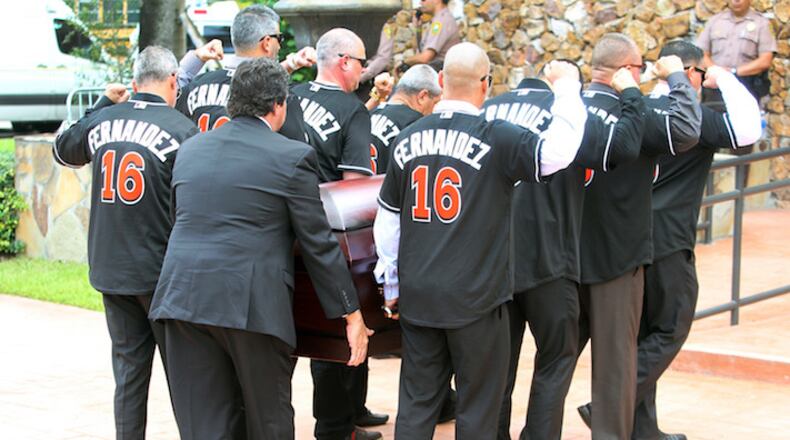The death of pitching ace Jose Fernandez in 2016 triggered a series of costly roster decisions that the Marlins' new owners are having to contend with now.
There is no shortage of 'what ifs' with how it all played out.
But this much is clear: according to sources with knowledge of internal discussions at the time, a number of players with prohibitive salaries wouldn't be on the Marlins now if previous owner Jeffrey Loria had listened to the advice of his top baseball people back then.
Absent a pitching ace in the wake of the Fernandez boating tragedy, the sentiment among many in baseball operations was that the Marlins would struggle to compete in 2017 and that a rebuild was the best path forward.
Instead, Loria dismissed the idea, opting to add Major League talent — rather than subtract — in what would be his final year as owner. As a result, the Marlins are saddled with a handful of expensive contracts that are either difficult, or impossible, to unload.
"The mandate was to win," said one source privy to the process.
And because of that mandate, the Marlins signed third baseman Martin Prado to a $40 million contract extension, signed starting pitcher Edinson Volquez to a $22 million deal, signed free agent relievers Brad Ziegler and Junichi Tazawa, and traded top pitching prospect Luis Castillo for Dan Straily.
Despite trading Giancarlo Stanton, Dee Gordon, Marcelo Ozuna and Christian Yelich this past winter, the Marlins are still projected to start the season with a total payroll of about $95 million — the third-highest Opening Day payroll in franchise history.
But nearly half of that amount is earmarked for players who are either no longer with the club (Volquez) or expected to start the season on the disabled list (Prado and Wei-Yin Chen).
The impact of the Fernandez tragedy continues to be felt.
"The fortunes of the franchise just turned upside down," said one source familiar with the baseball decisions that were made by Miami in the aftermath. "It was tough. There was no playbook with something like that."
Fernandez and two companions were killed Sept. 25, 2016, when the pitcher's boat crashed into a jetty off Miami Beach. In the days leading up to that tragedy, though, the Marlins were quietly preparing for the season ahead, reaching a non-binding agreement with Prado on a three-year contract extension.
It was all kept hush-hush.
But within days of the Fernandez boating accident, as the South Florida community was mourning the pitcher's death, the team's top baseball executives gathered in an office at Marlins Park to re-think their plans.
Without Fernandez, the Marlins lacked a top-of-the-rotation ace, a pitcher regarded as one of the best hurlers in the Majors. Could the Marlins win without a pitcher like him?
Many in the organization didn't think so and expressed their belief that tearing down the roster as part of a rebuild was the wisest action to take. At least one member of the group suggested that the team back out of its verbal agreement with Prado, a respected clubhouse leader who was chosen to speak on behalf of his teammates at the team's press conference the morning of the Fernandez accident.
"If ever anyone were to understand, it would have been then," one source said of backing out of what was a good-faith deal with Prado. "Even the staunchest of critics would have had to understand. It made sense."
But Loria didn't care for a retreat and instead gave orders to search for roster reinforcements.
The deal with Prado was signed, completed and announced on Oct. 5.
In an effort to patch up their rotation, the Marlins on Dec. 1 signed Volquez.
The Marlins also decided that, in order to help compensate for a deficient starting staff, they would try to strengthen their bullpen and made runs at a pair of high-profile free agent closers, Aroldis Chapman and Kenley Jansen.
When those two pitchers landed elsewhere, the Marlins lowered their sights, signing Tazawa on Dec. 16 and Ziegler on Dec. 23.
On Jan. 19, they acquired another big-league starter in Straily by trading Castillo, one of their few desirable prospects, to the Reds.
One month later, Loria announced he was selling the team.
The plan didn't pay off. The Marlins went 77-85 for their eighth consecutive losing season. Loria sold the team at the conclusion of the season to a group headed by Bruce Sherman and Derek Jeter, who promptly began unloading salary and re-stocking a depleted farm system by launching their own rebuild, trading off stars such as Stanton, Ozuna, Gordon and Yelich.
They're on the hook for the $13 million they owe Volquez, who underwent Tommy John surgery last season, likely won't pitch in the upcoming one, and is now the property of the Texas Rangers.
They're paying $13.5 million to Prado, who missed of the 2016 season with leg injuries and is expected to start the season on the disabled list. They'll also be paying $9 million to Ziegler and $7 million to Tazawa — two contracts that other teams probably wouldn't touch if the Marlins decided to trade either.
They'll also be paying $18 million to Chen in combined salary and deferred signing bonus.
It all adds up to a lot of money on the books.
While it's doubtful the Sherman/Jeter group would have kept Stanton if the Marlins could have trimmed payroll elsewhere, they could have perhaps held on to Yelich and/or Ozuna.
Nobody will ever know.
"The moment that boating accident occurred, the fortunes of that franchise changed," one source said.
About the Author
Keep Reading
The Latest
Featured


